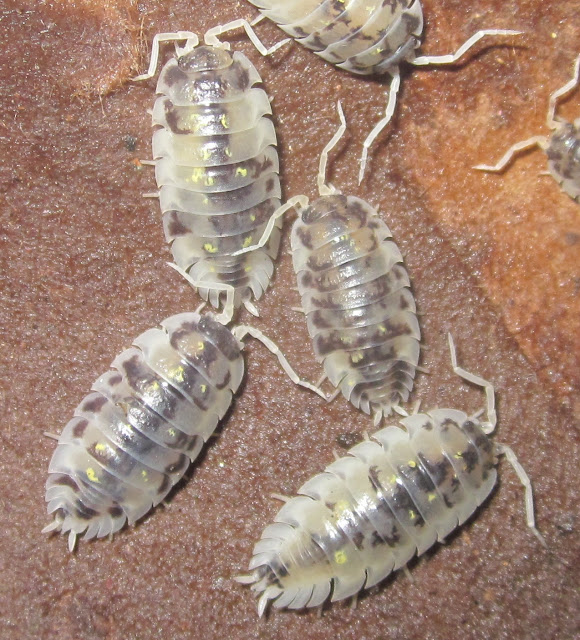I first isolated this strain in 2016, from an culture of normal looking O.asellus I'd been culturing successfully since 2012/2013. I was among the first to breed O.asellus successfully for multiple generations (which for some reason was a difficult task for many others back then, though now few people seem to have much issue culturing this species), and I was the first to isolate an actual morph of this species! 😃
Evidently years and years of inbreeding will inevitably cause mutations and morphs to pop up in isopod cultures, as I started getting a lot of interesting morphs and mutations to pop up in that colony... However the "Mardi Gras Dalmatians" were the most striking of said mutations (and the only one I isolated and established in culture sadly).
Laura Mae Riepl (of Smug Bug) was the one who coined the term "Mardi Gras Dalmatian", I had originally just been calling them "Dalmatian" morph Oniscus, which is what they are. However since most locales of this species have yellow flecking on them, and this carries over to the "Dalmatian" morph, some people didn't think the plain name "Dalmatian" really applied, since Dalmatian dogs don't have yellow coloration on them...
Now this may be considered a spicy take, and no ill will intended towards Laura of course... but in retrospect I feel it may have been better to just keep the morph name as "Dalmatian", since the yellow flecking isn't the result of a different mutation, just normal coloration for this species to have that gets carried over to all morphs this species produces (Dalmatian, Orange, Pied, White, Dark, Tan-ish, etc., all color mutations I've seen of this species can have yellow flecking on their backs).
It'd just have been a bit more technically accurate to label all standard Dalmatian strains of this (and other) species as "Dalmatian - LOCALITY", or some other similar format. Now we have "Mardi Gras Dalmatian" and "Starburst Dalmatian" morphs of O.asellus in the hobby, two different morph names, but really they appear to be the same general "Dalmatian" mutation, just from two different locales (with the "Starbursts" supposedly having more consistent yellow flecking, though that's more likely a result of locality differences, not a different mutation or anything). Same goes for Orange mutations in this and other species, we keep making up new, gimmicky morph names for mutations that already have names... like calling the "Orange" mutation O.asellus in the hobby "BC Maple", they should technically be referred to as O.asellus "Orange - BC" in my opinion... "Dalmatian" morph Porcellionides pruinosus have been coined as "Oreo Crumble", "Dalmatian" mutation Porcellio laevis are labeled as "Dairy Cows", etc... It's fun and all to come up with new, catchy morph names, but for known morphs that already had standardized names, I wish we'd have stuck to those standard morph names, followed by locality information when relevant. It feels more neat and less confusing that way. But that's just a pet peeve of mine I guess, I don't think most other isopod keepers would agree with me on this one. 😅
Anyways, let's get back on track here... I've got my 14 individuals housed in a moderately ventilated enclosure with a thin layer of coconut fiber as the substrate, with leaf litter, sphagnum moss and cardboard hides on top. I'm keeping them cool and humid, and am feeding them dog food in addition to their leaf litter.
Here are some pics of my babies:
So glad to have these back in my possession, isolating this morph and introducing them to culture was one of my favorite accomplishments in this hobby. 😊
Anyways, that's gonna do it for this post! Stay tuned, I've got some truly awesome new additions to US Blatticulture to show off in my next series of posts! 😁 Thanks for reading, hope you all enjoyed, stay safe, and I'll see everyone next time! 😉







Well shoot, I haven't had a strong urge to _buy_ colourful isopods, but if I can try to culture something from all those free Oniscus asellus out in the garden, on this side of the pond... that might be another matter.
ReplyDelete(Photos on the British Myriapod and Isopod Group website show that O. asellus has an orange form too, like various Porcellio. That could be interesting to find.)
Congrats on getting some of these back, and kudos on isolating them in the first place?
Also, yeah, all those _names_ are something that turns me off a little, too. It's vaguely confusing and, rightly or wrongly, puts me in mind of reptile inbreeding.
Same here, all the isopods I've been getting have been for free or in trades lol. But yeah if you can get a good enough starter colony going from your backyard, give it a few years of inbreeding and eventually you might have some neat ones popping up! (Alternatively you could get super lucky and actually find a mutant in your backyard from the get go).
DeleteThanks, appreciate it, definitely cool to have my original morph back! 😁
Exactly, funnily enough a LOT of reptile breeders got into keeping isopods in the past few years, which is probably where the naming mentality comes from (that and the insane pricing).
Shout out to my mom for the trade material. 🤣
ReplyDeleteHope you can get a nice, big culture established again!
Oh I forgot she's technically the one who owns these, my bad! 😂 Tell her I say thanks!
DeleteThanks, I hope so too! 😁